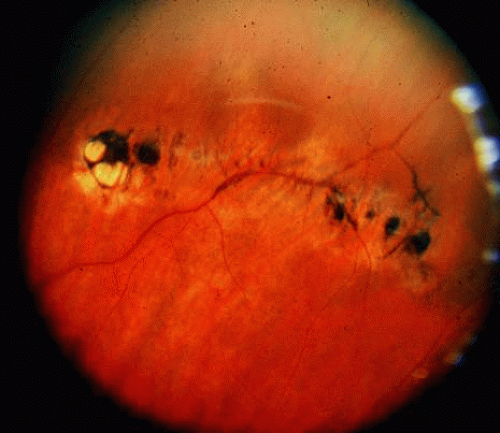Laser and Cryotherapy Treatment for Retinal Tears
Magdalena F. Shuler
William Tasman
Retinal tears are commonly treated with either laser photocoagulation or cryotherapy. The goal of treatment is to form a chorioretinal seal around the retinal break to avoid the passage of fluid into the subretinal space. The treatment of a retinal tear and the modality of treatment applied are dependent on the presentation and clinical findings.
TREATMENT PURPOSE
Retinal tears cause rhegmatogenous retinal detachments (RRD) by allowing fluid to enter the subretinal space. When a retinal tear has significant vitreous traction, fluid may enter even more readily. Retinal tears in the superior retina can lead to RRD more rapidly because of gravitational forces. In contrast, retinal tears in the inferior retina often are more chronic and slower to advance. Evidence of chronicity consists of pigmented demarcation lines.
Both laser photocoagulation and cryotherapy are used to create a firm adhesion between the retina and retinal pigment epithelium. Chorioretinal scarring occurs in 7 or more days with cryotherapy, but an earlier retinal adhesion is noted with laser.1
TYPES OF RETINAL TEARS
Clinical examination to identify retinal tears requires binocular indirect ophthalmoscopy with scleral indentation.2 Not all retinal tears require treatment. A symptomatic retinal tear is defined as a full-thickness retinal break caused by vitreoretinal traction associated with symptoms of floaters and/or photopsias (Fig. 1). While not all retinal tears require intervention, symptomatic retinal tears should be treated to prevent RRD. An operculated retinal hole associated with symptoms may warrant either observation or treatment depending on its clinical appearance. The presence of pigmentation around the hole with no vitreoretinal traction or no significant fluid suggests chronicity, and observation should be considered (Fig. 2).
An asymptomatic retinal tear is a full-thickness retinal break not associated with symptoms. Significant evidence suggests that patients with asymptomatic retinal tears may be observed.3,4,5,6 In fact the effectiveness of treating asymptomatic retinal tears in preventing RRD is unproved.7,8 Retrospective analyses have shown that subsequent posterior vitreous separation in eyes with preexisting asymptomatic retinal tears does not predispose to subsequent RRD.6 However, the prophylactic treatment of some retinal tears may be considered.
Recent evidence suggests that the fellow eye of patients with RRD is at considerable risk of developing rhegmatogenous events.9 Treatment of fellow eyes of patients with RRD can be considered, but RRD can still arise despite prophylactic laser.10 Patients with RRD caused by giant retinal tears (GRT, tear encompassing greater than 3 clock hours) are a specific subgroup of patients at risk for rhegmatogenous events in the fellow eye. Some recent evidence suggests prophylactic 360-degree cryotherapy treatment in the fellow eye of patients with RRD caused by spontaneous GRT should be considered but this is not universally accepted.11
Prophylactic treatment of patients planning on undergoing other ocular procedures can be considered. Asymptomatic retinal tears or extensive lattice (Fig. 3) with traction (Fig. 4) may warrant prophylactic treatment prior to intraocular surgery such as cataract extraction with intraocular lens implant. Prophylactic treatment of myopic eyes prior to LASIK is controversial but may be considered if extensive lattice and/or traction exist. Recent evidence suggests that prophylactic treatment of asymptomatic retinal tears be considered prior to yttrium-aluminum garnet (YAG) laser posterior capsulotomy in high-risk eyes with axial myopia.12
 FIG. 3. Extensive lattice degeneration in a myopic patient.
Stay updated, free articles. Join our Telegram channel
Full access? Get Clinical Tree
 Get Clinical Tree app for offline access
Get Clinical Tree app for offline access

|

